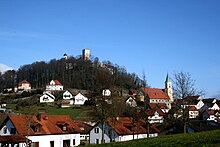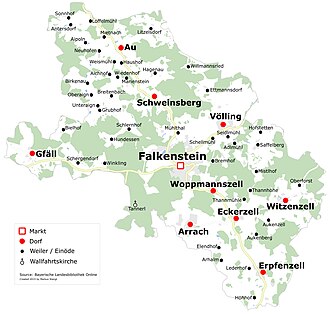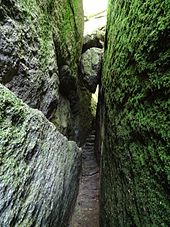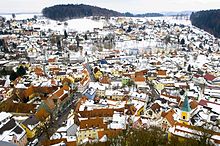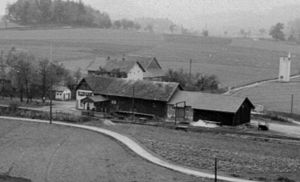Falkenstein (Upper Palatinate)
| coat of arms | Germany map | |
|---|---|---|

|
Coordinates: 49 ° 6 ' N , 12 ° 29' E |
|
| Basic data | ||
| State : | Bavaria | |
| Administrative region : | Upper Palatinate | |
| County : | Cham | |
| Management Community : | Falkenstein | |
| Height : | 573 m above sea level NHN | |
| Area : | 45.46 km 2 | |
| Residents: | 3399 (Dec. 31, 2019) | |
| Population density : | 75 inhabitants per km 2 | |
| Postal code : | 93167 | |
| Area code : | 09462 | |
| License plate : | CHA, KÖZ, ROD , WÜM | |
| Community key : | 09 3 72 125 | |
| Market structure: | 53 districts | |
Market administration address : |
Marktplatz 1 93167 Falkenstein |
|
| Website : | ||
| Mayoress : | Heike Fries (non-party (elected from the list of voters in Falkenstein-Völling)) | |
| Location of the Falkenstein market in the Cham district | ||

Falkenstein is a market in the district of Cham in the administrative district of Upper Palatinate in Bavaria with the seat of the administrative community Falkenstein .
From the landmark of the community, the Falkenstein Castle , an important landmark in the Falkensteiner Vorwald , the view extends from the tower to the Great Arber in the east when the visibility is good .
Already in 1496 the place had market rights . Falkenstein has been a state-approved climatic health resort since 1961 and forms the center for the surrounding communities; around 1900 the market was already known as a health resort .
geography
Geographical location
Falkenstein, the second largest market in the Cham district, is located in the Upper Bavarian Forest Nature Park and is a central location between Regensburg , Schwandorf , Cham and Straubing . The closest cities are Wörth an der Donau (15 kilometers southwest) and Roding (16 kilometers northeast). The Perlbach flows through the community area . In the middle of the market, on the highest elevation (628 m), is the Falkenstein Castle .
The Falkensteiner Vorwald forms a sub-unit of the Bavarian Forest . Compared to the flat Gäuboden and the Danube valley, it is a low mountain range. In this area the hardest rocks such as granite and gneiss are on the surface of the landscape. The soil consists mostly of gritty, loamy and sometimes stony sand. The landscape is particularly distinctive with numerous water sources, smaller bodies of water and wet meadows. Depending on the watershed , the waters flow into the rain depression to the north or south into the Danube . In the area between the Danube Valley and Cham-Further Senke there is a comparatively high density of castles and monasteries compared to the neighboring areas.
Neighboring communities
The following municipalities are residents; These are named clockwise starting in the north: Roding in the Upper Palatinate district of Cham , Michelsneukirchen in the district of Cham, Wiesenfelden in the Lower Bavarian district of Straubing-Bogen , Rettenbach in the district of Cham, Brennberg in the Upper Palatinate district of Regensburg , Zell in the Cham district.
climate
The Falkensteiner Vorwald has a central European continental climate . In the winter months from December to March there is a particularly rough climate of over 500–600 m with a continuously closed snow cover. With southerly and westerly winds, the clouds coming from the flat Danube valley accumulate on the slopes of the Falkensteiner Vorwald forest, which in some cases leads to heavy incline precipitation. With north and east wind, the Falkensteiner Vorwald lies on the leeward side of the Bohemian Forest, which is over 1400 m high . There is hardly any precipitation, warmer foehn winds set in in the Falkensteiner Vorwald . Such eastern weather conditions are much rarer than the high winds from the west, so there is an average annual rainfall of 782 mm in Falkenstein.
|
Average monthly temperatures and rainfall for Falkenstein
Source: - CLIMATE-DATA.ORG
|
|||||||||||||||||||||||||||||||||||||||||||||||||||||||||||||||||||||||||||||||||||||||||||||||||||||||||||||||||||||||||||||||||||||||||||||||||||||||||||||||||||||
history
Origin of name
Over the centuries the place name changed from Volkhenstain to Valckhinstain to Falkenstein .
The name Falkenstein is derived from the builder of Falkenstein Castle at the time. The construction of the castle took place at the time when the mighty Counts von Bogen held the cathedral bailiwick of Regensburg . The castle was not run by the Counts of Bogen, but by a faithful named Falko . The thus founder of the baron family of Falkensteiner became. At that time it was common for castle owners to give the castles their names.
Prehistory and early history
The first people in the area around Falkenstein may have been around since the Paleolithic . This is evidenced by finds such as hunting weapons and sacrificial stones in the surrounding districts.
First evidence
In 914 Konrad I gave away the Reichsforst, in which Falkenstein was also located, to the Hochstift Regensburg . Towards the end of the 10th century, the Regensburg bishops then opened up the area between Regensburg , Cham and Straubing . They had villages and castles built, the castles were used to protect the Slavs advancing westward . Falkenstein was first mentioned in a document in the writings of the Regensburg bishopric as the bishopric vogtei in 1074 .
Middle Ages (time to 1500)
A castle was built to protect the Falkenstein residents who settled at the foot of the mountain. The place below the castle was surrounded by a wall with four gates to protect against advancing enemies. The lords of the castle of Falkenstein were also judges over their subjects, whereby they were usually represented by a caretaker . It was not uncommon for a keeper to rule instead of the lords of the castle. In Falkenstein there was a district judge since 1358; he spoke in the right and name of the duke. In the Middle Ages, the Falkenstein rulership had lower and higher jurisdiction. It was not until the late Middle Ages and modern times that this judicial power passed to state courts. Death sentences were carried out on the Galgenberg, north of Völling, with the rope. He was later executed by the sword. The headstay was in the area of the schoolhouse and later below the poor house.
From 1130 to 1131 Falkenstein Castle was besieged by Duke Heinrich the Proud , after which the previous owner, Friedrich II von Bogen, got Falkenstein Castle back. During the Hussite War around 1425, attempts were made to defend against the Bohemian Hussites . Women and men wanted to drive the attackers down from the castle kennel together. Since then, the castle kennel has been called Weiberwehr . In the attack, however, the Hussites triumphed and their leader Tristam Zenger besieged the castle in 1428 and set the market on fire. However, Falkenstein Castle was recaptured by Duke Ernst on July 27, 1429 . In 1456 the newly built market burned down to two houses; In 1524 the church was on fire.
Modern times
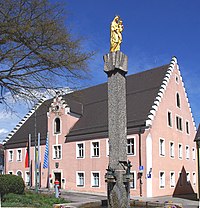
In 1634, during the Thirty Years War , Falkenstein was burned down to 17 houses by the Swedes and Falkenstein Castle was taken. A year later, in March 1635, the Swedes were driven out of Falkenstein by the Austro-Bavarian army under the leadership of Count Pikkolomini. Then the plague raged . In 1641 the Swedes came to Falkenstein a second time under Field Marshal Johann Banner , the market was burned down, but the castle and some houses remained under the Bavarian occupation. In 1648, at the end of the Thirty Years' War, the Swedes came one last time. Under the leadership of General Königsmarck and Rittmeister Hans Polmann, they gathered in the Bürgerholz to burn down the castle. They became aware of the good armament of the castle, turned away from the castle and devastated the surrounding villages such as Rettenbach, Schergendorf and G Cards . In the years that followed, the area was poor. In 1710 the plague raged again in Falkenstein. During this time, the lords of Törring built a new nursing home, now the town hall, and the old nursing home (Gasthof Zur Post) was given up. During the Austrian War of Succession , in autumn 1742, Austrian troops arrived. The opposing French camped at Wörth a. d. Danube and Brennberg . In the winter of 1744, cuirassiers from Hungary and Bohemia, the Barthelot Hussars (232 men), the Warasdiner Regiment (237 men), Wurmbrandt infantry, Karl Hussars and the Bernklau infantry (428 men) quartered in Falkenstein and the surrounding area . The infantry regiment of Field Marshal Count Merzi followed and then the Gyulani regiment. The Bavarian War of Succession and the Napoleonic Wars followed from 1778 to 1808 . On August 11, 1800, a fire broke out in the market that quickly spread; 38 houses, the school and the church burned down. Another fire started on September 13, 1846, only a few houses were spared. Since this fire, the houses in Falkenstein have been built of stone, before they were made of wood. In the course of Falkenstein's long history, the place had to endure numerous sieges, fires, famines and epidemics, but also the plague. This led to a decimation of the population and allowed little economic and social stabilization. Falkenstein was incorporated into the Upper Palatinate on October 1, 1831 .
In 1852 a district court was established in Falkenstein for the 12 surrounding communities. For this purpose, the community leased the nursing home as a courthouse. In addition, a prison was set up for minor crimes. The court in Mitterfels and the court in Straubing were responsible for serious crimes . In 1862 a hospital was built in Falkenstein, which also included a poor house . At that time Falkenstein had about 582 inhabitants. In 1877 a larger hospital was built, which was taken over by the Roding district association in 1952 .
After Falkenstein, with around 650 inhabitants , had to surrender its district court to the Roding District Court in 1879 due to the reorganization of the Bavarian judiciary , it had lost considerable political and economic importance. The Falkensteiner citizens then formed a railway committee. The chairman was Pastor Josef Kilger von Heilbrunn , who was largely responsible for the construction of the Regensburg – Falkenstein railway line . With the local railway, which went into operation in 1913, the post lines to Wörth ad Donau and Cham were discontinued.
Post-war and modern
In 1933, shortly after the NSDAP came to power , all local councils and district council members who did not belong to the NSDAP party had to resign. Catholic associations, mothers 'associations, virgin congresses and boys' associations were also dissolved and all activities outside the church were banned. On April 23, 1945, a column of inmates was driven from the Flossenbürg concentration camp through Falkenstein. About 30 bodies were discovered on the way from Gfung to Falkenstein. On April 24, 1945, American troops came from the east; guns were set up at the Quirin . The Falkensteiner pastor Josef Heigl handed over the Falkenstein market in Völling to the US Army without a fight. When the US Army moved in, the then mayor Theodor Albrecht committed suicide.
After the war, the population increased from 800 to 1,400 people due to displaced persons. In 1949, settlements were built to counter the housing shortage. With the beginning of the reconstruction after the Second World War , Falkenstein developed into a center for the surrounding communities through the resident companies of the manufacturing industry as well as the craft and service companies. New settlements emerged and the market grew steadily. In 1967 the Markt received the castle von den Thurn und Taxis for the symbolic price of one mark. In the years that followed, the market town had the castle completely restored and converted into a guest house .
In the course of urban redevelopment numerous measures were carried out to keep the place attractive, especially for vacationers and tourists. However, the closure of the railway line to Regensburg and the departure of an industrial company left large gaps in the center of the market. In the years that followed, Falkenstein invested in infrastructure projects and was able to redesign streets, paths and squares inside the market. A redesign of the main thoroughfares and the market square is still pending.
The community is currently setting the course for investments in regenerative energy, energy-saving technology, as well as in the provision of broadband internet access and the further development of the infrastructure. The Falkenstein-Erbsengrund development area and the Falkenstein-Arracher-Höhe and Völling industrial areas were recently created.
Cold War
On March 10, 1953, an F-84 fighter of the US Air Force crashed near Falkenstein, the pilot was able to save himself with the ejection seat and was uninjured. Two US F-84 fighter planes had entered the airspace of Czechoslovakia . Then they were caught and pursued by two Czechoslovak MiG-15 fighter planes near Pilsen . A US fighter was shot down, the plane crashed near Falkenstein.
Market rights
In 1496, Duke Albrecht the Wise signed a new document on Falkenstein's market privileges. Falkenstein had market rights before that ; the certificate was destroyed in a fire. Under the rule of Hieronymus von Stauff in 1514, the market privileges for the citizens were nullified. For over three centuries there have been disputes between citizens and rulers in Falkenstein. Between 1810 and 1860 there was no mayor, the market and administration were run by a caretaker. Falkenstein had the right to hold a Viktualienmarkt every Thursday as well as a market day on Kirchweihtag (Exaudison Sunday) and on the feast of the church patron.
Incorporations
On January 1, 1971, the previously independent municipality of Au was incorporated. Arrach was added on July 1, 1971.
Population development
Between 1988 and 2018 the market grew from 2,999 to 3,388 by 389 inhabitants or 13%.
| year | 1939 | 1950 | 1961 | 1970 | 1991 | 1995 | 2005 | 2010 | 2015 |
| Residents | 2345 | 3268 | 2753 | 3013 | 3036 | 3179 | 3342 | 3241 | 3257 |
religion
At the beginning of 2011, 86% of the population were Catholic, 6.2% Protestant and 7.8% belonged to another or no religious community.
Roman Catholic Church
The Catholics belong to the parish in Falkenstein, which is assigned to the diocese of Regensburg. In addition to the parish church of St. Sebastian, there are also the subsidiary churches of St. Josef in Gälle , as well as St. Peter and Paul in Marienstein and the mission house, a retreat house of the Pallottines , for the Seven Sorrows of Mary in Hofstetten.
Evangelical Lutheran Church
The Evangelical Christians in Falkenstein belong to the Evangelical Lutheran Church Community in Roding. There is also the Falkenstein Christ Brotherhood , an evangelical religious order .
Politics and administration
Community structure
There are 53 parish parts:
The districts Arrach, Au and Falkenstein exist in the municipality . A small part of the Falkenstein district is also on the Rettenbacher Flur.
Municipal council
The Falkensteiner local council consists of 16 voluntary councilors and the full-time first mayor. The body was last elected on March 15, 2020 for the term from May 1, 2020 to April 30, 2026, and is represented by:
- Falkensteiner list 6 seats
- Voting community Arrach 4 seats
- Voting community Au 3 seats
- Völling community of voters 3 seats
mayor
- Acting First Mayor
Heike Fries (Voting Association Falkenstein-Völling) was elected mayor for the first time on June 25, 2017; on March 15, 2020 she was confirmed in office for six years with 84.0% of the votes.
- Second and third mayors
Second mayor is Joachim Eberl (Falkensteiner list), third mayor is Eberhard Semmelmann (WG Arrach).
First mayor since 1594
The mayors were elected on Ash Wednesday in the Middle Ages. The term of office lasted one year and had to be confirmed by the lord of the castle. First mention of a mayor: Michael Amann, Sternwirt (1594–1611)
coat of arms
|
Blazon : "In blue on a black three-mountain, a golden falcon ready to fly."
The coat of arms has been known since the 15th century. |
|
| Justification for the coat of arms: A falcon on a mountain stands for the Falkenstein market. The Falkenstein market developed below a large rock where Falkenstein Castle is located. The current coat of arms in the semicircular shield goes back to the earliest imprint of the seal in 1514. The colors of the current coat of arms differ from the coat of arms from around 1562. The colored depiction, drawn by Philipp Apian , should probably refer to the rule of the Wittelsbacher ( since 1514) point out; on a blue background a tinged falcon and a silver three-mountain. In the 19th century different coats of arms were proven u. a. a hunting falcon with a red cap and a red bell is shown. |
Partnerships
The community maintains partnerships with the following communities of the same name:
-
 Falkenstein in the Palatinate , since 1976
Falkenstein in the Palatinate , since 1976 -
 Falkenstein in Lower Austria , since 1976
Falkenstein in Lower Austria , since 1976 -
 Falkenstein in Vogtland , since 1990
Falkenstein in Vogtland , since 1990
Since 2008 there has been a sponsorship with the 2nd company of Logistics Battalion 4 (Roding) of the Bundeswehr.
Culture and sights
theatre
The Burghofspiele Falkenstein (June to August) have been held in the courtyard of the castle since 1976 . Sophisticated materials and topics are presented under professional direction. The proximity to the audience in the manageable courtyard creates a pleasant theatrical atmosphere.
Museums
The Hunting and Game Museum has existed at Falkenstein Castle since 1982 . In this museum, a large number of specimens from animals, some of which are endangered, especially birds, from the region are on display. Furthermore you can find historical hunting weapons and hunting trophies. One focus of the museum is falconry . In the museum there are different exhibition topics on: The importance of hunting in human history , the development of hunting weapons , hunting and nature conservation , hunting trophies and charivari and the pickling .
Buildings
There are a large number of architectural monuments in Falkenstein.
Churches and monasteries

Another attraction in the center of the market is the parish church of St. Sebastian , which dates back to a building from the 17th century, with a hipped saddle roof and former choir flank tower, three-aisled basilica western extension with a retracted apse, romanised, 1934.
In addition to the parish church, there are six other branches:
The pilgrimage and ancillary church to the Scourged Savior in Tannerl : suction. Tannerl Chapel , eaves saddle roof construction with retracted choir and roof turret, late 17th century; the equipment was renewed in 1949/50.
In Eckerzell, the St. Florian village chapel : eaves and hipped gable roof building with shingled roof turrets , probably early 19th century; with equipment.
The side church of the Holy Family in Erpfenzell: gable hall building with hipped gable roof, recessed choir, choir flank tower and plaster frames, it is neo-Gothic, built between 1894 and 1896, with furnishings.
A monastery chapel for the Seven Sorrows of Mary in the Hofstetten Monastery: semicircular hall building with hipped gable roof, facade tower with pointed roof and plastered structures, neo-Gothic, inscribed. 1897.
In Marienstein there is the branch church St. Petrus und Paulus : hall building with retracted flat apse, basement, hipped gable roof in sheet metal and west tower with onion dome, 1719 ff., Renewed after fire in 1821, with furnishings; on a high rock base; Rocks by the tower with niche housing and pass-through.
The rococo church St. Valentin in Arrach: hall building with retracted choir, saddle and hipped roof, the facade tower has an onion dome and plaster structures, the choir is Gothic, the nave was built in 1750–1752, late baroque, rel. 1752; with equipment; the cemetery chapel is a square building with a tent and bell roof, 18th century; Closed cemetery ring through a quarry stone wall with leg shingle roof, 18th century.
In Gfäll the branch church St. Joseph. : Hall building with apse, recessed choir and sacristy of attached, gabled roof, the bell tower has an onion dome, built from 1953 to 1955.
Castles
The Falkenstein Castle is a castle completely preserved from the Middle Ages. The castle can be visited all year round, and the tower can also be visited at any time. The castle has a hunting museum and a restaurant with a pension. The Falkensteiner Burghofspiele take place in summer .
Next to the castle is the castle park, the second largest nature and rock park in Bavaria. The castle was built by Bishop Tuto of Regensburg and was first documented in 1074. In its more than 900-year history, Veste Falkenstein has changed hands frequently. Bishops, cathedral bailiffs, barons, counts, dukes, princes and kings called Falkenstein their own, a total of at least 18 different noble families are recorded. The Toerring-Jettenbachs and the Princes of Thurn und Taxis sat the longest at the castle .
The Sengersberg castle ruins are located in the Au district . It is the ruin of a hilltop castle on the 613.7 meter high rock summit of the Sengersberg, 170 meters above the Perlbach near the district of Au.
Parks

At the end of the 18th century, when the castle was no longer inhabited, complex trees grew around the castle hill and the castle park was created . The castle park in Falkenstein is the second largest rock park in Bavaria. The park is designated as a nature reserve Schlosspark Falkenstein , consists largely of deciduous trees, but is no longer used for forestry purposes. It also offers shelter and food for numerous rare animals and plants. You can find luminous moss , which is very rare in Germany . When light falls, this type of plant reflects an emerald green sheen.
In the park there are particularly pronounced granite stones with wool sack weathering and rock lanes, such as As the frog mouth and Stone streets , the small ski jump , the hollow stone , the Hermitage and the pericardial sac streets . These rocks with wool sack weathering were created over millions of years through the effects of water and ice.
There is also the so-called Königsplatz, which got its name from the visit of King Maximilian and Queen Marie as well as the noble nobles Maximilian von Thurn and Taxis and his wife Helene on July 3, 1852.
In the castle park there is also a historical shooting range of the castle lords from the 18th century with a large stone table. The former defensive weir , the Schanzl, is located near the castle .
In the vicinity
Supraregional hiking trails
Falkenstein is on the Goldsteig hiking trail.
This runs from Zell over the rock park near Falkenstein and continues to the Tannerl and then over the Höllbachtal , Stallwang , Konzell to Sankt Englmar .
Attractions
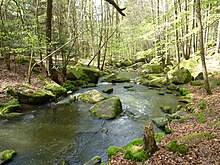
Höllbachtal between Brennberg and Rettenbach, Nepal-Himalaya-Pavillon in Wiesent, Castle Wörth an der Donau , Walhalla in Donaustauf, pile near Roding , castle ruin Lobenstein in cell, castle ruins victory stone at Süssenbach, castle in Brennberg , castle ruins Neuhaus in Schorndorf .
Geotopes near Falkenstein:
Sports and clubs
The largest club in the market is the gymnastics and sports club TSV v. 1948 with departments for several sports, u. a. Football, stick shooting, volleyball, tennis, judo, Nordic walking, gymnastics, women's gymnastics, winter sports. The TSV sports facilities are well developed with two soccer fields, three tennis courts, a school sports facility and the TSV sports center. In addition to the TSV, there is also the DJK Arrach sports club with a soccer field and sports center in Arrach. In addition, there is a bowling alley in Falkenstein and a mini golf course in the outdoor pool. Another soccer field is located in the Glassung district .
There is also a local history association in the market that takes care of numerous tourist events. Cultural round tables , exhibitions, folklore evenings , wine markets, the Falkensteiner cultural summer and culture at the castle as well as Advent events are held.
Falkenstein is the stage of the International Tour of Bavaria and the location of the Arber Cycle Marathon .
Other clubs
There are over 40 other clubs, one of the oldest is the Schützengesellschaft 1860 Falkenstein .
The Falkenstein volunteer fire brigade (founded on April 11, 1869) and the district's volunteer fire brigades provide fire fighting, fire protection and general help in the municipality and beyond.
leisure
The leisure offer is extensive and geared towards tourism. The Upper Bavarian Forest is located at an altitude of 600 to 1100 meters. This is also known for its abundance of snow, which means that there are many winter sports opportunities in this region. Winter sports are also practiced in the municipalities of Falkenstein, Wiesenfelden and Brennberg . A plateau (600–700 m) near Falkenstein is particularly suitable for cross-country skiers. There are four groomed cross-country trails in Falkenstein: Tannerl circuit 7 km, Ölbergkapelle circuit 3 km, embankment trail to Gfalls 7.5 km, Ruderszell circuit 4.5 km, Wiesenfelden connecting trail 10 km. In Falkenstein and in Rettenbach (Schmalzlalm) there is a ski lift with floodlights and a ski lift hut. You can play curling, ice hockey and ice skating on the ponds and ponds in the community. There is a sauna in the basement of the outdoor pool building. The next indoor swimming pool is in neighboring Wörth an der Donau .
From spring to autumn there are weekly guided hikes through the Falkensteiner Vorwald. Numerous herbal tours and mental fitness training are offered on the Falkensteiner Herb Trail, led by a MAT trainer and herbalist.
The former railway path with connection to the Danube Cycle Path offers a cycling and hiking tour to Regensburg. In Falkenstein there is a Kneipp pool with a Kneipp pond for alternating foot baths. There is a heated outdoor pool with a cafeteria, sunbathing area, beach volleyball court and mini golf course. On October 9, 2014, the “fitalParc” exercise course opened in the area of the outdoor pool. It consists of several consecutive devices that develop the sense of coordination and train strength. There are numerous ponds and streams for fishing. Equestrian sport is offered in Bruckmühl near Michelsneukirchen .
Regular events
The cultural life offers a number of regular events: twice a year - in mid-May and early June - there is an “Exaudimarkt” with Fieranten from the near and far inside the market. Every year before Christmas there is a Christmas market on the former station area. In addition, there are numerous regular events organized by over 40 local associations.
Culture
The former engine shed in Falkenstein is used for exhibitions of all kinds. Numerous local artists and associations use the premises for changing events.
Economy and Infrastructure
Falkenstein has a well-developed infrastructure with doctors, a pharmacy, grocery stores and numerous trade, craft and service companies. The economy is relatively dependent on tourism.
Established businesses
The Pressol lubrication GmbH is located a 1914 Manufacturer of lubrication equipment and workshop technology and since 1964 in Falkenstein.
tourism
A tourism office and a tourism association were set up in Falkenstein. The main focus of tourists are holiday guests, followed by "day trippers and overnight travelers".
A Falkenstein PLUS card has been introduced for tourists and vacationers . This card is an all-inclusive card , is reissued year after year and enables holiday guests in the climatic health resort who are subject to a health resort contribution as well as the participating hosts and businesses around Falkenstein and in the other communities of the Bavarian Forest to use various facilities in Falkenstein and the surrounding area during their stay free to use. The city of Wörth an der Donau is also taking part in this campaign with its indoor swimming pool. The cardholders also receive additional services and discounts from various service partners in a partner network in the region and throughout the Bavarian Forest . Long-term holiday guests of the place are rewarded by the mayor and the respective host for their loyalty as part of a guest honor.
The intermunicipal overall package "Winter and hiking paradise" was founded with the communities of Rettenbach and Brennberg. The aim of this initiative is to make rural areas attractive.
Working group of the Upper Bavarian Forest
On January 8, 2007, the working group for the Vorderer Bayerischer Wald, or “AG Vorwald” for short, was founded. The aim of the working group is to promote and strengthen the region in terms of tourism, economy and culture. Members of this community are the communities Altenthann , Bernhardswald , Brennberg , Falkenstein, Michelsneukirchen , Rettenbach , Wald , Wiesenfelden , Zell and the city of Wörth an der Donau , as well as all local, tourism and tourist associations in these communities.
traffic
With the loss of importance of the railway, the road connection was upgraded in the 1970s. Falkenstein is on the state roads St 2146 and St 2148 . Both state roads lead to Autobahn 3 (Nürnberg – Regensburg – Passau).
State roads
Geresdorf ![]() - St 2148 - Falkenstein - St 2148 - Wiesenfelden -
- St 2148 - Falkenstein - St 2148 - Wiesenfelden -![]()
Cham (Upper Palatinate) St 2146 - Falkenstein - St 2146 - Wörth an der Donau -![]()
Cham (Upper Palatinate) St 2146 - Falkenstein - St 2153 - Brennberg - St 2145 Forstmühle
Former rail traffic
From December 21, 1913 to June 1, 1984 Falkenstein was the terminus for passenger trains on the Regensburg – Falkenstein railway line . One year later, on June 2, 1985, freight traffic was discontinued and the railway line was dismantled in the following years up to 1992 and a cycling and hiking trail was then built. The Falkensteiner Bockerl , as it was popularly known, was of great importance to Falkenstein. Only the engine shed remains from the train station in Bahnhofstrasse. The station building was demolished in 1988.
Public facilities
There are the following municipal institutions in Falkenstein:
- Recycling center
- Sewage treatment plant
- kindergarten
- Day nursery
- Fairground
- Charging station for electric cars
- library
- Hunting and game museum at Falkenstein Castle
education and Science
The Falkenstein elementary and middle school (all-day school) is located in Falkenstein. As part of the intermunicipal cooperation, the Middle School Association of the Vorderer Bayerischer Wald - Donautal was founded in April 2010 . This school network is considered to be a showcase project across all districts and districts.
The members of the school association are:
- Middle School Association Wörth-Wiesent, consisting of the city of Wörth an der Donau , Wiesent municipality, Pfatter municipality, Bach an der Donau municipality
- Middle School Association Falkenstein, consisting of the market Falkenstein, municipality Rettenbach , municipality Brennberg
- Community Wiesenfelden
media
The Donau-Post , a local edition of the Straubinger Tagblatt , the Bayerwald-Echo , a local edition of the Mittelbayerische Zeitung and every Wednesday the Chamer Rundschau , a weekly newspaper of the MZ appear.
Personalities
Honorary citizen
- Joseph Kilger (born January 18, 1865 - † May 20, 1941), pastor
- Ernst Girmindl, former district administrator
- Hanskarl Winklhofer (born January 20, 1926 - † June 7, 2019) pharmacist and church musician
Sons and daughters of the church
- Max Schmalzl (* 1850; † 1930), Redemptorist and church painter
- Franz Xaver Reichhart (* 1851; † 1934), executioner
- Hanns Fleischer (* 1890; † 1969), tenor buffo
- Adolf Windorfer (* 1909; † 1996), pediatrician
- Johann Meier (* 1923; † 1992), priest and boarding school director of the elementary school of the Regensburger Domspatzen
- Josef Senft (* 1944), theologian and university professor
- August Laumer (* 1970), theologian
literature
- Josef Heigl: History of Falkenstein / Opf. Falkenstein 1954
- Harald Schumny: Falkensteiner Heimatheft 4 - Stories from the Past December 2011
- Harald Schumny: Falkensteiner Heimatheft 6 - Hunting and Game in the Falkensteiner Vorwald November 2014
Web links
- Homepage Market Falkenstein
- Local government
- Falkenstein (Upper Palatinate): Official statistics of the LfStat
- Falkenstein market in the Bavaria Atlas
- Literature by and about Falkenstein in the catalog of the German National Library
- Falkenstein: History and culture in the portal of the Free State of the Bavarian State Library Online
Individual evidence
- ↑ "Data 2" sheet, Statistical Report A1200C 202041 Population of the municipalities, districts and administrative districts 1st quarter 2020 (population based on the 2011 census) ( help ).
- ↑ The Falkenstein Municipal Council 2020-2026. Falkenstein parish, accessed on June 28, 2020 .
- ↑ Front Bavarian Forest. Bavarian State Office for the Environment , accessed on January 17, 2016 .
- ^ Front Bavarian Forest - Eggerszell private weather station
- ↑ a b c d e f History of Falkenstein / Opf. Falkenstein , Peter Heigl, 1954
- ↑ The Falkensteiner Bockerl , Peter Heigl, 1993
- ↑ a b Falkensteiner Heimatheft 4 , Harald Schumny, Dec. 2011, pp. 7–9
- ^ Czech Radio, October 4, 2004
- ^ Wilhelm Volkert (ed.): Handbook of Bavarian offices, communities and courts 1799–1980 . CH Beck, Munich 1983, ISBN 3-406-09669-7 , p. 559 .
- ^ Bavarian State Office for Statistics. Falkenstein market. Municipal statistics 2014 ( Memento of the original from January 14, 2017 in the Internet Archive ) Info: The archive link was inserted automatically and has not yet been checked. Please check the original and archive link according to the instructions and then remove this notice. PDF, Munich 2015, p. 6.
- ↑ Bavarian State Library Online
- ↑ Members of the municipal council from May 2020 , accessed on August 15, 2020
- ↑ Entry on the coat of arms of Falkenstein (Upper Palatinate) in the database of the House of Bavarian History , accessed on August 6, 2020 .
- ↑ Falkenstein Castle Park, the second largest nature and rock park in Bavaria
- ^ Arbeitsgemeinschaft Vorderer Bayerischer Wald [1] , accessed on December 26, 2014.
- ↑ Middle School Association Archive Link ( Memento of the original from December 19, 2014 in the Internet Archive ) Info: The archive link has been inserted automatically and has not yet been checked. Please check the original and archive link according to the instructions and then remove this notice. Front Bavarian Forest, accessed on December 14, 2014.



